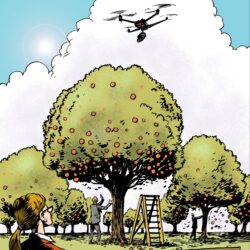Garvis integrates ChatGPT into its planning tool

An enthusiastic audience of more than 600 supply chain professionals from around the world discovered that ChatGPT is much more than an amusing and somewhat unreliable plaything during Webinar Wednesday on 12 April. Coffee producer JDE demonstrated how this artificial intelligence (AI) tool can be used to chat with the Garvis demand planning system, generating easy-to-understand answers to complex questions about changing demand patterns. This innovation by Garvis sets a new standard in supply chain planning.
By Marcel te Lindert
Imagine being able to chat with your demand planning tool. For example, if you ask the system for the three best-selling products in a particular product category in the past month, you receive the answer in everyday language, including a graph with the corresponding sales figures. You can then ask follow-up questions, such as what percentage of the revenue was linked to promotions or seasonal effects.
Coffee and tea producer Jacobs Douwe Egberts (JDE) has precisely such a planning tool, meaning that JDE’s demand planners no longer have to navigate through screens full of tables and charts with data and filters to find the information they’re looking for. “They can now just type in their query, and the requested information is displayed on the screen within seconds,” said Tineke Kok, who is responsible for integrated business planning (IBP) within JDE. “A good demand planner knows how to navigate the system, of course, but if you have a specific question this works faster and much more intuitively.”
Integration in Garvis
Kok was referring to the demand planning system from Belgian scale-up Garvis. It has developed the chat feature by integrating ChatGPT, the AI chatbot that has been attracting worldwide attention since its introduction in November. “The idea for integrating ChatGPT into Garvis arose in January, when a customer commented that Garvis needed to show a lot more graphs to be of interest to large companies. That got us thinking. Why graphs? Why not ChatGPT? Because then you could ask pretty much anything rather than being limited to graphs.”
That includes questions not only from demand planners, but also from senior managers, such as those asked during the final meeting of the monthly sales & operations planning (S&OP) cycle. “Wouldn’t it be great if general managers themselves could simply type in their own questions? We spend hours on preparing a PowerPoint presentation for senior management containing all the information and associated explanations. Now, it’s just a matter of asking Garvis the right questions,” Kok said.
The story behind the numbers
JDE is a long-standing user of Garvis to gain a better understanding of the factors impacting on demand. Kok stated: “Our company is driven by price changes, promotions and new product introductions. And also by events such as COVID-19 – which reduced coffee consumption at work and on the go and increased it at home – and by inflation, which affects consumer purchasing power. Demand planners are responsible for translating all these factors into a forecast for both the short term and the long term. Garvis helps us to better understand the past so we can better predict the future.”
Garvis also allows demand planners to link any increase or decrease in demand patterns to an ‘event’ such as a promotional campaign, a price increase, a product introduction or even a lockdown. In turn, the system learns about the impact of these events on the demand pattern so that, if the event occurs again in the future, that impact can be taken into account when calculating the forecast. This results in a more reliable forecast. “It remains important to understand the story behind the numbers. Demand planners are our company’s ‘conscience’,” continued Kok.
iPhone moment
During the webinar, Piet Buyck, CEO and co-founder of Garvis, explained in detail how the ChatGPT integration works. “Basically, what Garvis does is digitize demand planners’ insights. We can integrate those insights into the Large Language Model (LLM) that forms the basis of ChatGPT. Every time an insight is added to Garvis, it is condensed into a chunk of information that ChatGPT can use in its responses,” Buyck told the viewers.
Incorporating external information opens up even more possibilities. “In that case, besides telling you that your sales growth is mainly linked to promotional campaigns, for example, it could also tell you that your company is losing market share. Additional information like that can put things in a totally different perspective,” Buyck stated. He called it an ‘iPhone moment’ for supply chain planning: “The big question is how complex processes and technologies can be made more accessible for people. Thanks to ChatGPT, plain language becomes the interface of such systems.”
Faster decision-making
There are major benefits to using ChatGPT, according to Kok: “We can now gain insights and make decisions much faster. It’s now also possible for sales managers – who generally don’t like navigating their way through information systems – to ask questions about market developments or changes in their product portfolio.”
In Buyck’s view, there are infinite possibilities: “Users no longer have to click through to the right graph; they can just request it. The chat function can be used to create the standard reports. And users may also be able to ask strategic questions in the future, such as ‘What do I need to do to meet targets?’ and ‘Where is the best investment opportunity?’ for instance.”
JDE is currently rolling out Garvis to various countries both within and outside of Europe. This is a relatively easy process because the system does not require a lot of configuration. “We have the same standard system that we can implement everywhere, and then everyone can just ask their own local questions,” commented Kok.










